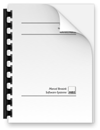TinkerTool System 6
 Staying ahead
Staying ahead
Many competitors have tried to copy TinkerTool and TinkerTool System in the last 19 years. The applications became role models for a whole generation of numerous Mac system utilities. With their superior technologies, for example multi-version OS support with adaptive user interfaces, or full security integration, the TinkerTool programs have always been ahead, however.
Of course, the renowned and innovative features which have been introduced by previous generations of TinkerTool System, such as using temporary file cache deactivation instead of the bad “cache cleaning”, or showing removal previews of files which are going to be deleted in a cleaning operation, do still work as before, just as you are used to.
Security
TinkerTool System 6 is a “real” macOS application and does not make use of unsafe scripting mechanisms. The application follows Apple's latest security guidelines. The graphical user interface is strictly separated from the operational core which is capable of performing privileged system operations.
 Safety and Know-How
Safety and Know-How
When resolving typical system problems, TinkerTool System attempts to follow Apple's official support guidelines. This does not mean that TinkerTool System will execute a certain troubleshooting procedure word by word. For example, the program will not simulate the entry of terminal commands if Apple lists them in step-by-step troubleshooting instructions. However, TinkerTool System will execute direct internal commands which will have the exact same effects. Users can press a special help button in TinkerTool System to check whether Apple offers official documents about certain system problems in their database. If such documentation is available, the user can click one or more Internet links to open up-to-the-minute information about the problem in question.
 Printed Manual
Printed Manual
TinkerTool System 6 comes with a detailed reference manual in Apple Help Viewer format. If you prefer a printed version of the manual, the documentation is also available as a PDF document (more than 300 pages). It can be downloaded separately.
Screenshots
Get a first impression of TinkerTool System 6 by looking at screenshots of a few selected features.
Features in Detail
TinkerTool System 6 contains all you need for Macintosh administration — and even more. The features marked with an asterisk (*) below are available without any restrictions even if the application runs in demo mode.
- Repeat the system optimization procedure of the Apple Installer if necessary.
- Clear the Directory Services cache and the cache of the name service (DNS) client.
- Enable or disable the system's maintenance job for the locate database.
- Let the system update the locate database immediately.
- Recreate the shared users folder in cases where it has mistakenly been deleted. (*)
- Troubleshoot application-related caches by the unique cache deactivation feature, avoiding the bad side effects of cache cleaning if possible.
- Clean users' high-speed caches or the core operating system caches.
- Clear and rebuild the font caches of a single user account or the whole operating system.
- Clear the icon caches of a single user account and the icon caches of the operating system.
- Clear and rebuild the startup driver cache of macOS.
- Clean or delete the contents of the staging folders macOS uses to prepare kernel extensions for user approval.
- Rebuild the system cache for Cross-Program Communication (XPC helper cache).
- Reassign a Time Machine backup set to a different computer.
- Reassign the history of a volume in a Time Machine backup set after this volume has been replaced by a new one with same contents.
- Compute the change rates between subsequent Time Machine snapshots.
- Verify the integrity of a selected volume backup in Time Machine.
- Determine the actual incremental storage size of a Time Machine snapshot.
- Create local APFS snapshot that can be used as restore point by one mouse click.
- Review the list of local APFS snapshots.
- Reclaim storage space used by local APFS snapshots.
- Delete selected local snapshots.
- Remove all local Time Machine APFS snapshots from a selected volume.
- Remove a Time Machine backup snapshot from an active backup.
- Remove Time Machine snapshots, backup sets, or all Time Machine data from local disk drives.
- Retrieve the internal logs for each Time Machine backup run.
- Reset a failing search for macOS software updates.
- Enforce immediate synchronization of the list of available packages for macOS software updates.
- Remove outdated notification entries from macOS Software Update.
- Resize disk images (DMG files) reliably, avoiding the defective feature of Disk Utility.
- Erase partitioning information from used disk drives to make them compatible with Disk Utility again.
- Evaluate memory statistics to assess if the installed RAM size is appropriate for the computer's workload. (*)
- Check if the current version of the macOS Finder is affected by certain defects which could lead to problems when copying files.
- Inspect technical details of optical disk media, like manufacturer, recording type, session information, etc.
- Verify if Trim commands are used for SSDs attached to your Mac.
- Test all controllable fans of your Mac and monitor their rotational speeds for diagnostic purposes.
- Retrieve the login time statistics kept by macOS. You can review total login time per user or total usage per day.
- Let Time Machine compare the backup sets for a volume at two different points in time, allowing you to monitor what files have changed and how Time Machine is operating.
- Check if Time Machine is operating correctly by comparing the current data on your computer with a backup set.
- Launch an emergency utility which can help you even if macOS is suffering from major damage (see below).
- Create standalone installation media for macOS and OS X versions 10.9 or later
- Download selected macOS installer apps provided by Apple without use of the App Store (macOS Catalina or later only).
- Get information about the production date of your Mac. (*)
- Get detail information about the exact Intel processor type in your Mac. (*)
- Get information about components, expansion slots, jumpers and other details from the system management database built into your Mac. (*)
- Create system inventory files or print-outs.
- Display the current status of the operating system's anti-malware protection system. (*)
- Show the current blacklist of macOS used to automatically deactivate App Nap and HiDPI functions ("Retina display mode”) in certain applications. (*)
- Show the current blacklist of macOS used to automatically prevent the launch of certain applications or the used of specific kernel extensions. (*)
- Get access to log files and reports kept by macOS and its subcomponents. (*)
- Review or export log entries from the macOS logging and tracing subsystem.
- Create symbolic links and hard links as an alternative to classic Mac OS aliases or bookmarks in the file system.
- Protect or unprotect files or a whole hierarchy of folders.
- Make files invisible or change their type and creator codes.
- Analyze and remove quarantine data of files or bundles.
- Let macOS analyze the true contents of files, independent of type codes or file name extensions. (*)
- Retrieve all Spotlight metadata the system has stored for a file. (*)
- Enforce deletion of protected files or a hierarchy of folders.
- Remove Extended Attributes, including resource forks, from files.
- Check if file names and nesting depths of folder hierarchies exceed the maximum length for absolute paths that is guaranteed to be supported by applications. Check alternatively whether these files could be cloned to other volumes using absolute paths.
- Check if relative or absolute path lengths of a folder hierarchy exceed a specified limit.
- Remove Finder view settings from folders (.DS_Store files).
- Remove AppleDouble files (emulated forks or Extended Attributes on foreign file systems).
- Remove log file archives.
- Remove crash report files.
- Remove orphaned files and folders formerly owned by users who no longer have an account.
- Remove broken aliases from a hierarchy of folders.
- Clean Mac resources from external drives before the disks are given to users of foreign operating systems.
- Remove Post Mortem Core Dump files.
- Let TinkerTool System assist you in removing applications which have been installed by drag-and-drop operation. All user accounts can be cleaned from nearly all application-related files.
- Deinstall widgets, screen savers, preference panes, QuickTime plug-ins or Internet plug-ins.
- Show the security details of applications or other executable code, including “App class” status, Gatekeeper assessment, digital sealing, and individual definitions for the Application Sandbox. (*)
- Check the signature of modern software distribution disk images. (*)
- Check the notarization state of applications or software distribution images (macOS Catalina only). (*)
- Display and change the true permission setting of file system objects, getting full control over Access Control Lists (ACLs).
- Sort entries of Access Control Lists canonically.
- Remove inherited Access Control Entries.
- Make inherited Access Control Entries explicit.
- Propagate subsets of folder permissions onto a whole hierarchy of enclosed objects, including the feature to remove all ACLs
- Let TinkerTool System compute the effective permissions for a user accessing an object. (*)
- Get access to special permission settings of macOS.
- Find all internal identifications the system may use for user and group accounts.
- Run a bulk integrity check on all graphical applications in a folder or on an entire volume. Create a text report from the results.
- Review the different definitions of free and allocated storage space used by macOS for each volume. (*)
- List the system services currently registered to purge storage space when necessary. (*)
- Check the integrity of the system firmware immediately (only on Macintosh models where this is supported by Apple)
- Check the integrity of the firmware of Broadcom® Ethernet devices immediately.
- Get an overview on the current APFS configuration. (*)
- Review APFS snapshots and delete them if necessary.
- Copy APFS containers, volume groups, volumes or snapshots by fast replication (macOS Catalina or later only).
- Set the energy saver options for hard drives, specifying the exact sleep timeout.
- Disable throttling of low-priority I/O operations in the kernel
- Control whether macOS should mount secondary volumes before login (not necessary with macOS Catalina).
- Block disk volumes from automatic mounting and program execution.
- Show the size of Spotlight index databases on all supported volumes.
- Control operations of the Spotlight metadata stores per volume.
- Block selected disk volumes from all Spotlight operations.
- Define the default user for the password panel of the Finder when connecting to file servers.
- Unlock outdated authentication methods to connect to old AFP servers.
- Disable the assistant for Captive Networks (WiFi hotspots) (not necessary with macOS Catalina).
- Disable support for IPv6 on selected network interfaces.
- Unlock System Preferences to offer screen resolutions for HiDPI mode on standard screens, permitting to simulate Retina operation on non-Retina displays (not for macOS Catalina).
- Activate macOS's advanced preference pane for the Archive Utility.
- Remove custom preference panes from user accounts or the whole operating system.
- Control the permission filter that specifies which POSIX rights user applications are permitted to grant for new file system objects.
- Specify server and port number of the macOS Software Update Server.
- Change the user account security policy for Remote Apple Events (macOS Catalina or later only).
- Control the privacy guideline of the screen sharing feature of macOS.
- Disable automatic login even if FileVault 2 is enabled.
- Manage whether FileVault can keep the disk key in memory during standby mode.
- Control the job history policy of the macOS printing subsystem.
- Enable or disable the web interface of the printing subsystem.
- Disable automatic power-on for the latest mobile Macs that have an “always on“ design.
- Enable verbose startup of macOS.
- Select special maintenance OS versions for the next system start, like Recovery, Internet Recovery, or Apple Diagnostics.
- Enable the classic Macintosh startup chime on selected model series released after summer 2016.
- Disable the Dark Wake feature.
- Control whether processor cores should remain powered up even if they are idle.
- Enhance performance for server operation.
- Let the system load option-ROMs of third-party interface devices automatically, without having to confirm this with a key combination in the Startup Manager (only for Macintosh systems released before May 2015).
- Let the system use only one processor core or a limited amount of RAM for diagnostic purposes.
- Reconfigure kernel panic logging in case automatic recording of logs does not work for a serious panic problem (only if System Integrity Protection disabled).
- Control the NMI feature of Macs to start the remote kernel debugger (only if System Integrity Protection disabled).
- Disable 32-bit software in the entire system (only if System Integrity Protection disabled).
- Force macOS to separate kernel memory and user memory more strictly (only if System Integrity Protection disabled).
- Enable full mitigation against the ZombieLoad attack (only if System Integrity Protection disabled).
- Disable processor-assisted virtualization features which can enhance the stability of macOS Catalina (only if System Integrity Protection disabled).
- Overview and analysis of all auto-starting jobs configured for the current user. (*)
- Automatically remove invalid or outdated configuration entries for auto-starting jobs.
- Change the language setting for system startup and the login screen. (*)
- Set the display style of the login screen.
- Disable one or more power control buttons of the login screen.
- Enable additional features of the login screen.
- Control the screen saver of the login screen (not available in macOS Catalina).
- Enable Apple's basic screen saver for the login screen and set the message it should display (not available in macOS Catalina).
- Hide selected local accounts in the list of users on the login screen.
- Launch multilingual applications in a language different from your usually preferred one.
- Override your personal language preferences for the launch of specific applications. (*)
- Verify the integrity of preference files effective for a user account. (This includes actual checks on the preferences structure, not only simple syntactical checks of “plist” files.)
- Find preference files of network user accounts, removing files which refer to decommissioned computers.
- Let macOS rebuild the Launch Services Database for a selected user account.
- Edit the personal dictionaries of a user account created after learning unknown words via the macOS spell-checker.
- Repair the System Preferences application when it behaves erratically.
- Repair the macOS Help Viewer when it no longer works correctly.
- Repair the translation of folder names in a user's home folder.
- Reset your personal language settings to the system's defaults in case they have been damaged.
- Get advanced information about a user account, viewing details not visible in System Preferences. (*)
- Remove entries for recent items and recent servers from the Apple menu, the Finder, the Share feature, and all applications, protecting your privacy.
- Reset the privacy settings for selected domains to factory defaults that control which applications should have permission to access personal user data.
- Integrate the control panes of TinkerTool directly into TinkerTool System, getting access to the full feature set in a single control window. (*)
 Features of the Included Emergency Utility
Features of the Included Emergency Utility
TinkerTool System 6 comes with an additional emergency tool which can help you to troubleshoot macOS problems even if the graphical user interface is no longer starting, or the user account of the system administrator has been damaged. This standalone version is designed to be used in macOS Recovery Mode and includes the following features:
- Verify and repair the system's folder for the storage of temporary objects.
- Disable or enable System Integrity Protection (SIP).
- Deactivate corrupt preference files for a user account.
- Deactivate and reactivate cache contents of a user account.
- Deactivate and reactivate all preference settings of a user account.
- Deactivate corrupt system preference files.
- Deactivate and reactivate the contents of system-wide caches.
- Reset network-managed preferences.
- Reset the login screen
- Remove third-party startup objects.
- Disable automatic login.
- Force the system to re-run the Setup Assistant upon next startup, which can repair an unusable administrator account.
- Show hardware information, including processor details and the S.M.A.R.T. status of SATA hard drives.
